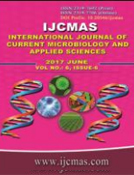


 National Academy of Agricultural Sciences (NAAS)
National Academy of Agricultural Sciences (NAAS)

|
PRINT ISSN : 2319-7692
Online ISSN : 2319-7706 Issues : 12 per year Publisher : Excellent Publishers Email : editorijcmas@gmail.com / submit@ijcmas.com Editor-in-chief: Dr.M.Prakash Index Copernicus ICV 2018: 95.39 NAAS RATING 2020: 5.38 |
Rice (Oryza sativa L.)‒wheat (Triticum aestivum L.) is the major cropping system in western Indo-Gangetic Plain of India. This system is very exhaustive and there is a need to include a leguminous crop in this system for sustainable agriculture. Field experiments were conducted for two years to explore the possibility of growing cowpea [Vigna unguiculata (L.) Walp.] and mungbean [Vigna radiata (L.) Wilczek] during March/April to June (the period available after harvesting of winter-season crops such as wheat and Brassica and before transplanting and sowing of rainy season crops) and the potential contribution of their crop residues for succeeding crops. Although grain yields were higher from 20 and 30 March sowings than 10 and 20 April sowings, the cowpea crop sown on 20 April produced acceptable yields compared with keeping the fields vacant. Cowpea produced higher grain and straw yields than mungbean. At maturity, after collecting the grain, the aboveground straw yields of cowpea varied from 2817 to 3940 kg ha-1, containing an estimated 34-48 kg N ha-1, which could be utilized by the succeeding crop. We conclude that cowpea may not only provide high grain yields, but also help in improving the soil health.
 |
 |
 |
 |
 |